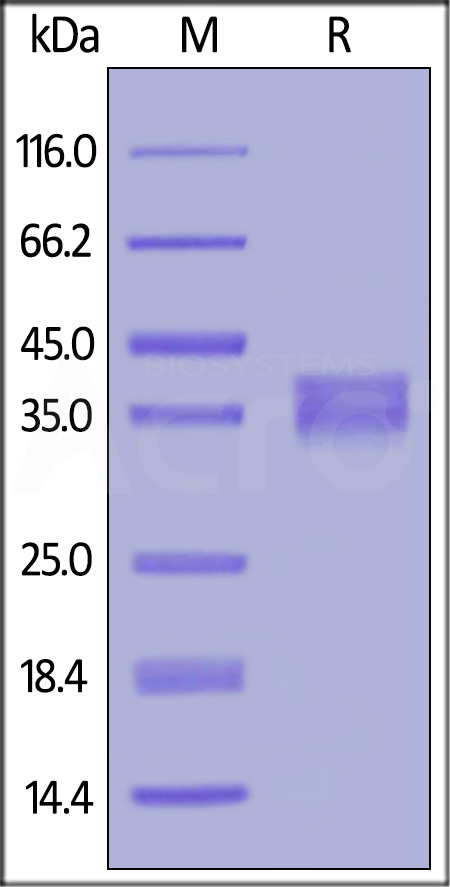分子别名(Synonym)
GPA33,A33
表达区间及表达系统(Source)
Mouse GPA33, His Tag (GP3-M5225) is expressed from human 293 cells (HEK293). It contains AA Leu 22 - Ile 235 (Accession # Q9JKA5-1).
Predicted N-terminus: Leu 22
Request for sequence
蛋白结构(Molecular Characterization)

This protein carries a polyhistidine tag at the C-terminus.
The protein has a calculated MW of 24.7 kDa. The protein migrates as 33-42 kDa under reducing (R) condition (SDS-PAGE) due to glycosylation.
内毒素(Endotoxin)
Less than 1.0 EU per μg by the LAL method.
纯度(Purity)
>95% as determined by SDS-PAGE.
制剂(Formulation)
Lyophilized from 0.22 μm filtered solution in PBS, pH7.4. Normally trehalose is added as protectant before lyophilization.
Contact us for customized product form or formulation.
重构方法(Reconstitution)
Please see Certificate of Analysis for specific instructions.
For best performance, we strongly recommend you to follow the reconstitution protocol provided in the CoA.
存储(Storage)
For long term storage, the product should be stored at lyophilized state at -20°C or lower.
Please avoid repeated freeze-thaw cycles.
This product is stable after storage at:
- -20°C to -70°C for 12 months in lyophilized state;
- -70°C for 3 months under sterile conditions after reconstitution.
电泳(SDS-PAGE)

Mouse GPA33, His Tag on SDS-PAGE under reducing (R) condition. The gel was stained with Coomassie Blue. The purity of the protein is greater than 95%.
背景(Background)
Glycoprotein A33 (GPA33) is also known as Cell surface A33 antigen, is a single-pass type I membrane protein which is expressed in normal gastrointestinal epithelium and in 95% of colon cancers. GPA33 The predicted mature protein has a 213-amino acid extracellular region, a single transmembrane domain, and a 62-amino acid intracellular tail. The sequence of the extracellular region contains 1 Ig-like C2-type (immunoglobulin-like) domain and 1 Ig-like V-type (immunoglobulin-like) domain characteristic of the CD2 subgroup of the immunoglobulin (Ig) superfamily, which contains. GPA33 may play a role in cell-cell recognition and signaling.























































 膜杰作
膜杰作 Star Staining
Star Staining











